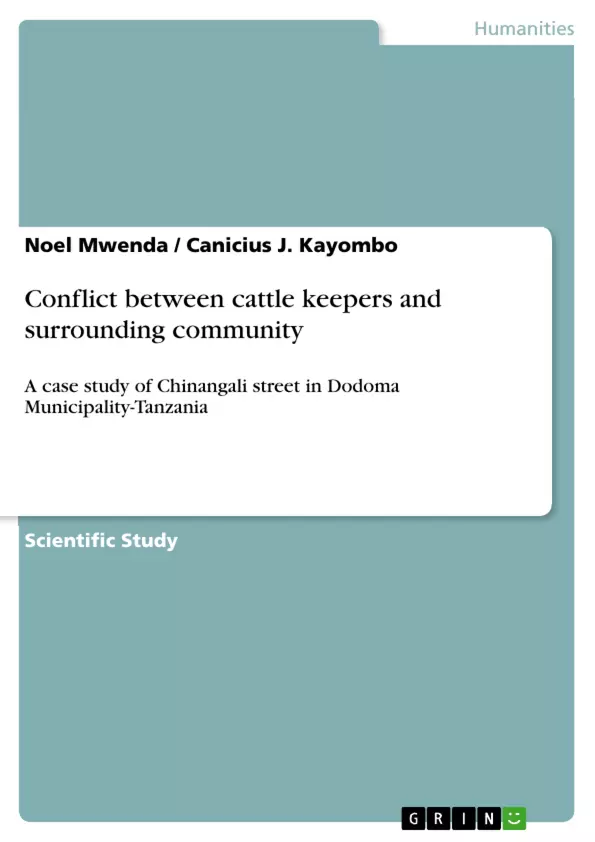A survey on the conflict between cattle keepers and surrounding communities was conducted at Maili Mbili-Chinangali street in Dodoma Municipality between December, 2010 and January 2011 to find out conflicts resulted by cattle keepers, as well as to assess factors for incompatible land use in the study area. 100m X 1000m [10hectares] transect walk was employed from Maili Mbili seasonal stream bridge to the end of Chinangali street. Questionnaire forms were used to collect data including three cattle keepers and three non-cattle keepers. Also, direct observation was applied whereby any revealed cattle were identified, counted and recorded. Digital camera was used to take photographs. The found cattle huts were recorded and photographed. Computer packages including micro soft excel, micro-soft word programs and calculator were used during data compilation and analysis. A total of 55 cows and 31 goats were identified. The total available hectares were 10, an indication that at least nine cattle occupy one hectare and practically one cow needs 3.2 hectares, while for the goat 1.2 hectares are required (see Table 1). There were a deficit of more than 70% for both cows and cattle (see Table 1). The factors for the conflicts were poor implementation of laws and bylaws by the government, low education to the community as well as poverty. Resources allocation has to be planned to avoid unnecessary conflicts for sustainable development. It is recommended that town planners and government as a whole should rely on the best quality of land use; also, more research is encouraged to find out the best solution for the existing communities conflicts.
Inhaltsverzeichnis (Table of Contents)
- Abstract
- Introduction
- Background information
- Problem statement & justification
- Methodology
- Study area
- Climate
- Temperature
- Vegetation
- Results & Discussion
- Conclusion and Recommendation
- References
Zielsetzung und Themenschwerpunkte (Objectives and Key Themes)
This study examines the conflict between cattle keepers and surrounding communities in Dodoma Municipality, Tanzania, focusing on the Chinangali Street area. The study aims to identify the conflict's root causes, assess factors contributing to incompatible land use, and recommend solutions for sustainable development.
- Conflict between cattle keepers and surrounding communities
- Incompatible land use in urban areas
- Factors contributing to conflict, such as poor law enforcement, low community education, and poverty
- Sustainable development solutions
- The impact of cattle grazing on the environment
Zusammenfassung der Kapitel (Chapter Summaries)
The introduction provides background information on cattle keeping practices in Tanzania and the challenges posed by free-grazing cattle in urban areas. The study focuses on Chinangali Street in Dodoma Municipality, where the conflict between cattle keepers and the community is particularly acute. The methodology section details the study area, climate, temperature, and vegetation characteristics. The results and discussion section presents findings on the conflict, the number of cattle in the area, and the factors contributing to land-use incompatibility. The conclusion and recommendation section summarizes the study's findings and offers recommendations for addressing the conflict and promoting sustainable development.
Schlüsselwörter (Keywords)
The study focuses on the conflict between cattle keepers and the surrounding community in urban areas, specifically in Dodoma Municipality, Tanzania. Key themes include incompatible land use, poor law enforcement, low community education, poverty, and sustainable development solutions. The research also explores the environmental impact of free-grazing cattle and the need for alternative practices like zero-grazing.
- Quote paper
- Noel Mwenda (Author), Canicius J. Kayombo (Author), 2011, Conflict between cattle keepers and surrounding community, Munich, GRIN Verlag, https://www.grin.com/document/191286



